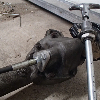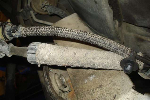- Joined
- February 15, 2010
- Messages
- 7,837
- Reaction score
- 24
- City, State
- Charlestown, RI
- Year, Model & Trim Level
- 2014 Escape SE
I noticed that several people have been asking how to test a relay lately, so I worked this up. Enjoy.
Be sure to check out my other write-ups:
How To: Replace Blend Door Actuator in 3rd Gen Ex
How To: Remove/Replace 3rd Gen Door Panel
How To: Install Signal Mirrors On 3rd Gen Ex
How To: Restore Faded, Yellowing Headlights
How To: Replace Multifunction Switch in 3rd Gen Ex
How To: Paint Rear Pillar Trim
How To: Replace 3rd Gen Ambient Air Temperature Sensor
How To: Remove/Replace 3rd Gen Center Console
Here is a basic automotive relay:

With no power on the coil there is a connection between pins 30 & 87a (closed), and no connection between pins 30 & 87 (open), as shown in the picture.
When power is applied to the coil (pins 86 & 85), there is a connection between pins 30 & 87 (closed), and no connection between pins 30 & 87a (open).
To test the relay, disconnect all wiring or remove it from it's socket. For the tests listed below, the meter will be set on Continuity/Resistance.

Step 1 is to test the Coil:
Step 2 is to test the Normally Closed Terminals :
Step 3 is to test the Normally Open Terminals :
If at this point the relay has proven to be good, The next step is to test that it functions properly when the coil is energized.
Step 4 is to test the Actual Function of the Relay :
Hope this helps out and didn't confuse you too much!

Be sure to check out my other write-ups:
How To: Replace Blend Door Actuator in 3rd Gen Ex
How To: Remove/Replace 3rd Gen Door Panel
How To: Install Signal Mirrors On 3rd Gen Ex
How To: Restore Faded, Yellowing Headlights
How To: Replace Multifunction Switch in 3rd Gen Ex
How To: Paint Rear Pillar Trim
How To: Replace 3rd Gen Ambient Air Temperature Sensor
How To: Remove/Replace 3rd Gen Center Console
Here is a basic automotive relay:
With no power on the coil there is a connection between pins 30 & 87a (closed), and no connection between pins 30 & 87 (open), as shown in the picture.
When power is applied to the coil (pins 86 & 85), there is a connection between pins 30 & 87 (closed), and no connection between pins 30 & 87a (open).
To test the relay, disconnect all wiring or remove it from it's socket. For the tests listed below, the meter will be set on Continuity/Resistance.
Step 1 is to test the Coil:
- Set the meter on Continuity/Resistance
- Test the continuity between terminals 85 & 86
- If meter measures Continuity/Resistance, the Coil should be good
- If the meter measures No Continuity/Resistance, the Coil is bad and the relay should be replaced
Step 2 is to test the Normally Closed Terminals :
- Set the meter on Continuity/Resistance
- Test the continuity between terminals 30 & 87a
- If meter measures Continuity, the Normally Closed Function of the relay should be good
- If the meter measures No Continuity, the Normally Closed Function of the relay is bad and the relay should be replaced
Step 3 is to test the Normally Open Terminals :
- Set the meter on Continuity/Resistance
- Test the continuity between terminals 30 & 87
- If meter measures No Continuity, the Normally Open Function of the relay should be good
- If the meter measures Continuity, the Normally Open Function of the relay is bad and the relay should be replaced
If at this point the relay has proven to be good, The next step is to test that it functions properly when the coil is energized.
Step 4 is to test the Actual Function of the Relay :
- Set the meter on Continuity/Resistance
- Connect one probe from the meter to Terminal 30 on the relay
- Connect the other probe to Terminal 87 on the relay
- At this point the meter is reading No Continuity
- Connect Terminal 85 to the Negative on the Battery
- Connect Terminal 86 to the Positive on the battery
- At this point the Coil is energized
- The meter should be reading Continuity
- If the meter is reading Continuity, the relay is good!
- If the meter is reading No Continuity, the relay is bad and should be replaced
Hope this helps out and didn't confuse you too much!











